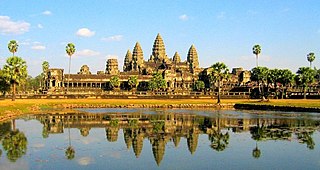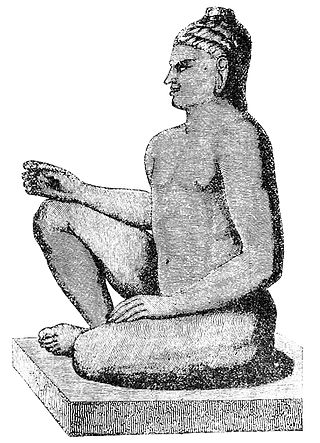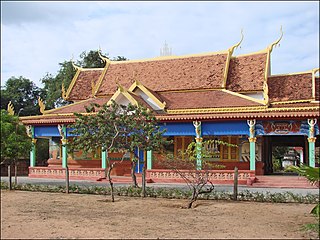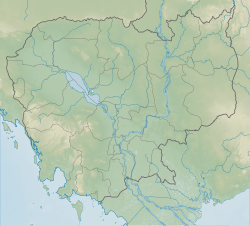
Khmer architecture, also known as Angkorian architecture, is the architecture produced by the Khmers during the Angkor period of the Khmer Empire from approximately the later half of the 8th century CE to the first half of the 15th century CE.

Angkor, also known as Yasodharapura, was the capital city of the Khmer Empire. The city and empire flourished from approximately the 9th to the 15th centuries. The city houses the Angkor Wat, one of Cambodia's most popular tourist attractions.

An apsaras or apsara is a member of a class of celestial beings in Hindu and Buddhist culture. They are originally a type of female spirit of the clouds and waters, who later plays the role of a "nymph" or "fairy". They figure prominently in the sculpture, dance, literature and painting of many South Asian and Southeast Asian cultures.

Angkor Wat is a temple complex in Cambodia, located on a site measuring 162.6 hectares. It resides within the ancient Khmer capital city of Angkor. The Guinness World Records considers it as the largest religious structure in the world. Originally constructed as a Hindu temple dedicated to the god Vishnu for the Khmer Empire by King Suryavarman II during the 12th century, it was gradually transformed into a Buddhist temple towards the end of the century; as such, it is also described as a "Hindu-Buddhist" temple.

Angkor Thom, alternatively Nokor Thom, located in present-day Cambodia, was the last and most enduring capital city of the Khmer Empire. It was established in the late twelfth century by King Jayavarman VII. It covers an area of 9 km², within which are located several monuments from earlier eras as well as those established by Jayavarman and his successors. At the centre of the city is Jayavarman's state temple, the Bayon, with the other major sites clustered around the Victory Square immediately to the north. The site is one of the major tourist attractions of Southeast Asia.

Thommanon is one of a pair of Hindu temples built during the reign of Suryavarman II (1113–1150) at Angkor, Cambodia. The name of the temple is derived from the Pali words "Dhamma", which means 'Buddhist Teachings' and "Nanda", which means 'supreme wisdom'. This small and elegant temple is east of the Gate of Victory of Angkor Thom and north of Chau Say Tevoda. It is part of the UNESCO World Heritage Site, inscribed by UNESCO in 1992 titled Angkor. The temple is dedicated to Shiva and Vishnu.

Phnom Bakheng is a Hindu temple in the form of a temple mountain in Siem Reap Province, Cambodia. Dedicated to Shiva, it was built at the end of the 9th century, during the reign of King Yasovarman (889–910). Located atop a hill, it is nowadays a popular tourist spot for sunset views of the much bigger temple Angkor Wat, which lies amid the jungle about 1.5 km to the southeast. The large number of visitors makes Phnom Bakheng one of the most threatened monuments of Angkor. Since 2004, World Monuments Fund has been working to conserve the temple in partnership with APSARA.

Battambang is a province of Cambodia in the far northwest of the country. Bordering provinces are Banteay Meanchey to the north, Pursat to the east and south, Siem Reap to the northeast, and Pailin to the west. The northern and southern extremes of the province's western boundaries form part of the international border with Thailand. In addition, Tonlé Sap forms part of the northeastern boundary between Siem Reap and Pursat. Its capital and largest city is Battambang.

Kampong Thom is a province (khaet) of Cambodia. It borders the provinces of Siem Reap to the northwest, Preah Vihear to the north, Stung Treng to the northeast, Kratie to the east, Kampong Cham and Kampong Chhnang to the south, and the Tonle Sap to the west.

Siem Reap, officially Siemreap, is a province (khaet) of Cambodia. It borders the provinces of Oddar Meanchey to the north, Preah Vihear and Kampong Thom to the east, Battambang to the south, and Banteay Meanchey to the west. Its capital and largest city is Siem Reap.

Yasovarman I was an Angkorian king who reigned in 889–910 CE. He was called "Leper King".

Beng Mealea, or Boeng Mealea, is a temple from the Angkor Wat period located 40 km (25 mi) east of the main group of temples at Angkor, Cambodia, on the ancient royal highway to Preah Khan Kompong Svay.

The history of Cambodian art stretches back centuries to ancient times, but the most famous period is undoubtedly the Khmer art of the Khmer Empire (802–1431), especially in the area around Angkor and the 12th-century temple-complex of Angkor Wat, initially Hindu and subsequently Buddhist. After the collapse of the empire, these and other sites were abandoned and overgrown, allowing much of the era's stone carving and architecture to survive to the present day. Traditional Cambodian arts and crafts include textiles, non-textile weaving, silversmithing, stone carving, lacquerware, ceramics, wat murals, and kite-making.

Siem Reap is the second-largest city of Cambodia, as well as the capital and largest city of Siem Reap Province in northwestern Cambodia.

Roluos is a Cambodian archeological site about 13 km east of Siem Reap along NH6. Once it was the seat of Hariharalaya, first capital of Khmer Empire north of Tonlé Sap.
A Dharmasala or a house of fire, or house with fire, is the name given to a place where people, especially pilgrims, can rest on a journey. It is a type of building found in Angkorian complexes constructed during the reign of late 12th-century monarch Jayavarman VII and still found in Preah Khan, Ta Prohm and Banteay Chhmar.

Wat Domnak is a famous Buddhist pagoda and one of the teaching monasteries in the city of Siem Reap, Cambodia.

Wat Vihear Suor is a Theravada Buddhist temple located in Kandal Province, Cambodia. It was built on an older pre-Buddhist cult site belonging to the Angkor era.

Wat Bakong (វត្តបាគង) is a Theravada Buddhist pagoda on the precincts of the Prasat Bakong in the Ruluos archeological area of the Siemreap Province.
The Poem of Angkor Wat, is a Khmer poem which dates from the beginning of the 17th century. It celebrates the magnificent temple complex at Angkor and describes the bas-reliefs in the temple galleries that portray the Reamker. The Poem of Angkor Wat is considered to be the earliest original literary work in Khmer language. It is one of the two great epic poems of Cambodia with the Reamker in the style of the Indian epic poetry.






















